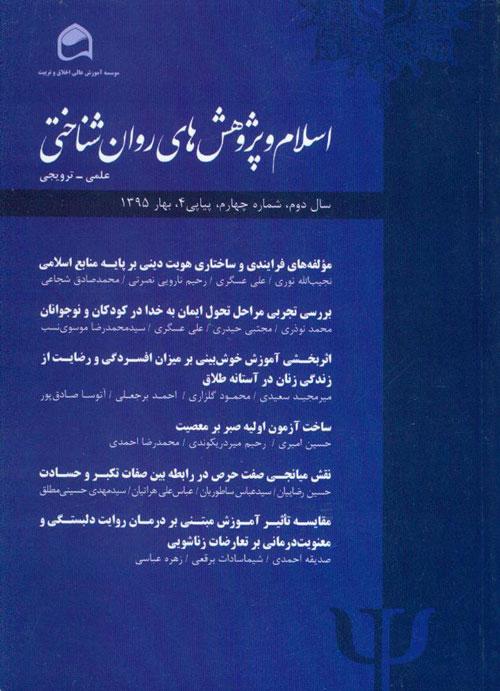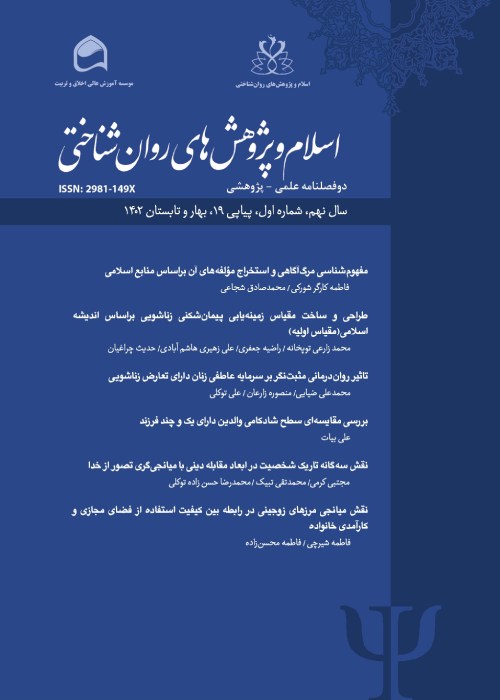فهرست مطالب

نشریه اسلام و پژوهش های روان شناختی
پیاپی 4 (بهار 1395)
- 122 صفحه،
- تاریخ انتشار: 1395/04/20
- تعداد عناوین: 7
-
-
صفحه 7هدف این پژوهش، شناسایی ساختار مولفه ای و مولفه های فرایندی هویت دینی از منابع اسلامی است. برای کشف مولفه ها از روش تحلیل محتوا و معناشناسی زبانی در یک طرح دو مرحله ای استفاده شد. روایی محتوایی مولفه ها، توسط کارشناسان علوم حوزوی که در روان شناسی یا علوم تربیتی تخصص داشتند، تایید شد. یافته ها نشان داد که پنج مولفه جست وجوگری، یکپارچه سازی، تعهد، هشیاری و خودپایی را می توان مولفه های فرایندی هویت دینی معرفی کرد. همچنین بر پایه یافته های این پژوهش هفت مولفه باورها، ارزش ها، اهداف، گرایش ها، صفات، توانمندی ها و آسیب پذیری ها مولفه های ساختاری هویت دینی به شمار می روند.کلیدواژگان: ساختار مولفه ای، هویت دینی، مولفه فرایندی، مولفه ساختاری، منابع اسلامی
-
صفحه 27هدف این پژوهش، بررسی تجربی مراحل تحول ایمان به خدا در کودکان و نوجوانان بر مبنای پژوهش نظری نوذری (1389) و با روش مقطعی انجام شده است. مولفه های ایمان به خدا در پژوهش حاضر عبارتند از: شناخت خدا، شناخت نظام معنایی، عاطفه ایمانی و التزام ایمانی. داده های پژوهش بر پایه روش بالینی و از طریق مصاحبه انفرادی نیمه ساخت یافته با 198 دانش آموز (دختر و پسر) 7 تا 17 ساله شهر قم-که به صورت تصادفی طبقه ای انتخاب شدند- گردآوری و توسط پنج کارشناس نمره گذاری شدند. داده ها با روش تحلیل واریانس مورد بررسی قرار گرفت. یافته ها نشان می دهد که با افزایش سن، سطح ایمان به خدا نیز افزایش و دگرگونی می یابد. همچنین بر پایه نتایج به دست آمده، روند تحول ایمان به خدا در کودکان و نوجوانان دارای مراحل ذیل است: ایمان حسی نامتمایز، ایمان مفهومی آموخته شده، ایمان انتزاعی سطح اول، ایمان انتزاعی کامل.کلیدواژگان: مرحله، تحول، ایمان به خدا، کودکی و نوجوانی
-
صفحه 55هدف این پژوهش، تعیین تاثیر آموزش خوش بینی بر میزان افسردگی و رضایت از زندگی زنان در آستانه طلاق شهرستان قم است. روش پژوهش نیمه تجربی از نوع پیش آزمون- پس آزمون با گروه کنترل بود. جهت اجرای پژوهش، 30 نفر از زنان در آستانه طلاق در دو گروه آزمایش (15 نفر) و کنترل (15 نفر) به طور تصادفی جایگزین شدند. متغیر مستقل خوش بینی بود که در 14 جلسه بر روی گروه آزمایش انجام شد و در گروه گواه هیچ مداخله ای انجام نشد. ابزار پژوهش مقیاس افسردگی بک ((BDI-II و مقیاس رضایت از زندگی داینر (SWLS) بود. برای تحلیل داده ها از تحلیل کواریانس استفاده شد. یافته های پژوهش نشان داد که خوش بینی در کاهش افسردگی زنان و افزایش رضایت از زندگی آنان موثر بوده است که با یافته های پژوهش های قبلی همسو است. یافته ها اطلاعات مفیدی را برای پژوهشگران، مشاوران و روان درمانگران در مورد اثربخشی خوش بینی فراهم نماید.کلیدواژگان: زنان در آستانه طلاق، افسردگی، رضایت از زندگی، آموزش خوش بینی
-
صفحه 71هدف این پژوهش، ساخت آزمون اولیه صبر بر معصیت است. در این پژوهش، با توجه به مولفه ها و نشانه هایی که در میان آیات و روایات شناسایی شده اند ، یک آزمون 44 ماده ای ساخته شد. برای کشف روایی محتوا از روش پیمایشی دلفی استفاده شد و در نهایت برای تشخیص اعتبار اولیه، آزمون روی 106 تن به طور آزمایشی اجرا و با استفاده از روش های آلفای کرونباخ، ضریب دونیمه سازی اسپیرمن و گاتمن، میزان اعتبار آن بررسی شد. پس از اجرای آزمون، برای کشف روایی سازه از روش همسانی درونی (با محاسبه همبستگی اسپیرمن) استفاده شد. روایی محتوای آزمون از تایید 8 نفر از کارشناسان به دست آمد. بعد از اجرای آزمایشی، اعتبار اولیه آزمون با توجه به میزان آلفای کرونباخ 93/0، همبستگی دونیمه سازی 86/0، ضریب دونیمه سازی اسپیرمن 93/0 و دونیمه سازی گاتمن 92/0 محاسبه گردید. برای بررسی روایی سازه، همبستگی خرده مقیاس ها با یکدیگر و با نمره کل مقیاس، همبستگی مولفه های هر خرده مقیاس با نمره کل و همبستگی هر گویه با نمره کل محاسبه شد که نتایج روایی سازه مطلوب در پرسش نامه را نشان داد.کلیدواژگان: صبر، معصیت، روایی و اعتبار، آزمون اولیه، اسلام
-
صفحه 85هدف این پژوهش، تدوین مدل روابط میان تکبر، حرص و حسادت است. این پژوهش، توصیفی از نوع همبستگی است و حجم نمونه آن 384 نفر از دانشجویان دانشگاه خمین می باشد که به روش نمونه گیری تصادفی چندمرحله ای انتخاب شدند. از مقیاس های اسلامی حرص- قناعت، تکبر- تواضع و نسخه تجدیدنظر شده حسادت برای جمع آوری داده ها استفاده شد که با استفاده از روش تحلیل مسیر و آزمون سوبل مورد تجزیه و تحلیل قرار گرفتند. شاخص ها نشان از برازش مطلوب مدل ارائه شده و تایید نقش میانجی حرص در رابطه بین کبر و حسادت دارد. نتایج نشان داد که صفت تکبر، ریشه بسیاری از احساس ها و صفات منفی از جمله حسادت خواهد بود که جا دارد به زیربناها، روابط و مکانیزم عمل این قبیل صفات اخلاقی بیشتر توجه شود.کلیدواژگان: نقش میانجی، تکبر، حرص، حسادت، صفت اخلاقی
-
صفحه 99هدف این پژوهش، مقایسه تاثیر آموزش مبتنی بر درمان روایت دلبستگی با معنویت درمانی بر تعارضات زناشویی است. جامعه آماری، کلیه زنان کارمند دارای تعارض زناشویی منطقه 7 و 8 تهران می باشند که 36 نفر به عنوان نمونه انتخاب شدند. ابزار پژوهش، پرسش نامه تعارضات زناشویی تجدیدنظرشده (MCQ-R) می باشد. طرح پژوهش از نوع پیش آزمون- پس آزمون با گروه کنترل است. پس از انتخاب تصادفی گروه های آزمایشی و کنترل، مداخلات آزمایشی برای دو گروه، به مدت 12جلسه دو ساعتی و هفته ای یکبار اجرا شد. پس از اتمام برنامه آموزشی، از هر سه گروه پس آزمون و سپس پیگیری به عمل آمد. برای تحلیل داده ها، از تحلیل کوواریانس و آزمون تعقیبی استفاده شد. یافته ها نشان داد که آموزش مبتنی بر درمان روایت دلبستگی و معنویت درمانی اثربخشی معناداری بر کاهش تعارضات زناشویی داشته است. بدین معنا که آموزش مبتنی بر معنویت درمانی، اثربخشی بیشتری نسبت به آموزش مبتنی درمان روایت دلبستگی بر کاهش تعارضات زناشویی داشته است. نتایج پیگیری نمرات دو گروه پس از سه ماه، حاکی از ماندگاری اثر مداخلات بود.کلیدواژگان: درمان روایت دلبستگی، معنویت درمانی، تعارضات زناشویی
-
صفحه 113
-
Page 7The present research aims at identifying the componential structure and process components of religious identity in Islamic sources. To discover the components, the methods of content analysis and linguistic semantic were used in a two-stage process. The content validity of the components was confirmed by some experts in seminary sciences who were specialized in psychology or educational sciences. The findings showed that five components (inquiry, integration, commitment, vigilance, and self-care) can be introduced as the process components for religious identity. Besides, based on the findings of the research, seven components including beliefs, values, goals, orientations, characteristics, abilities, and vulnerabilities are considered as structural components of religious identity.Keywords: Component Structure, Religious Identity, Process Component, Structural Component, Islamic Sources.
-
Page 27The present research aims at an empirical investigation of the stages of evolution in belief in God in children and juveniles based on Nowdharis theoretical research (2012) and was conducted through a cross-sectional method. The components of belief in God in this research are as follows: knowing God, knowing the meaning system, faith emotion and faith commitment. The research data were gathered through clinical method and a semi-constructed individual interview with 198 seven to seventeen years old students (males and females) in Qom selected through random classification, and were scored by five experts. The data were investigated through Analysis of Variance (ANOVA). The findings showed that as ones age increases, his level of belief in God also increases. Besides, based on the obtained results, the course of evolution in belief in God in children and juveniles has the following stages: undifferentiated sense of faith, learned conceptual faith, first-level abstract faith, complete abstract faith.Keywords: Stage, Evolution, Belief in God, Childhood, Adolescence
-
Page 55The present research aims at determining the effect of teaching optimism on the level of depression and life satisfaction in women on the verge of divorce in Qom. The research method was semi-empirical with pretest and posttest using a control group. To do the research, 30 women on the verge of divorce were randomly put in two groups (15 in control group and 15 in experiment group). The independent variable was optimism which was presented to the experiment group during 14 sessions. No manipulation was done in the control group. The research devices were Becks depression scale (BDI-II) and Dieners Life Satisfaction scale (SWLS). To analyze the data, analysis of covariance (ANCOVA) was used. The findings showed that optimism is effective in reducing womens depression and increasing their life satisfaction. This was in line with the findings of previous researches. The findings prepare useful information on the effectiveness of optimism for researchers, consultants and psychotherapists.Keywords: Women on the Verge of Divorce, Life Satisfaction, Teaching Optimism.
-
Page 71The present research aims at designing an initial test on patience with sins. In this research, in view of the parameters and signs identified in Quranic verses and traditions, a test with 44 items was designed. To discover the validity of the test content, Delphi Survey method was used; and to identify the primary reliability of the test, it was carried out on 106 subjects, and the reliability of the test was assessed through Cronbachs Alpha as well as Spearman and Guttmans split Coefficient. After carrying out the test, the internal consistency method was used (by calculating Spearmans Correlation) to discover the construct validity of the test. The content validity of the test was confirmed by 8 experts. After experimental execution of the test, the primary validity of the test obtained through Cronbachs Alpha was calculated to be 0.93, 0.93 through Spearmans split-half, and 0.92 through Guttmans split-half. To assess the construct validity of the test, the correlation of subscales with one another and with the whole scale, the correlation of each subscale with the total score, and the correlation of each item with the total score were calculated which then showed the desirable construct validity of the test.Keywords: Patience, Sins, Validity, Reliability, Initial Test, Islam.
-
Page 85The present research aims at compiling the model of relationship between pride, greed and envy. The research is of correlation type and was conducted on a sample population composed of 384 students in Khomein University, selected through multi-stage random sampling. The Islamic scales of greed/contentment and pride/ hiumily and the revised version of envy scale were used for gathering data, and the data were analyzed through Sobel test and path analysis. The indexes show the desirable fitness of the suggested model and support the mediatory role of greed in the relationship between pride and envy. The findings show that arrogance is the source of many negative feelings and characteristics including greed. It is necessary, thus, to pay more attention to the foundations, relations and mechanism of such moral characteristics.Keywords: Mediatory Role, Pride, Greed, Envy, Moral Characteristic.
-
Page 99The present research aims at a comparison between the effect of education based on attachment narrative therapy and spirituality therapy on marital conflicts. The statistical population consisted of all female employees with marital conflicts in district 7 and 8 of Tehran. 36 such women were selected as the sample population. The research device was the revised version of Marital Conflict Questionnaire (MCQ-R). The research design was of pretest/ posttest type with control group. After random selection of control and experiment groups, experimental manipulations were performed on two groups for 12 two-hour sessions twice a week. At the end of the educational period, the three groups were given the posttest and follow-up. To analyze the data, the ANCOVA and post hoc tests were used. The findings showed that education based on attachment narrative therapy and spirituality therapy have meaningful effects on reducing marital conflicts. Moreover, education on the basis of spirituality therapy is more effective in reducing marital conflicts in comparison to education based on attachment narrative therapy. The results of pursuing the scores of the two groups after three months suggest the durability of the effect of manipulations.Keywords: Attachment Narrative Therapy, Spirituality Therapy, Marital Conflicts


